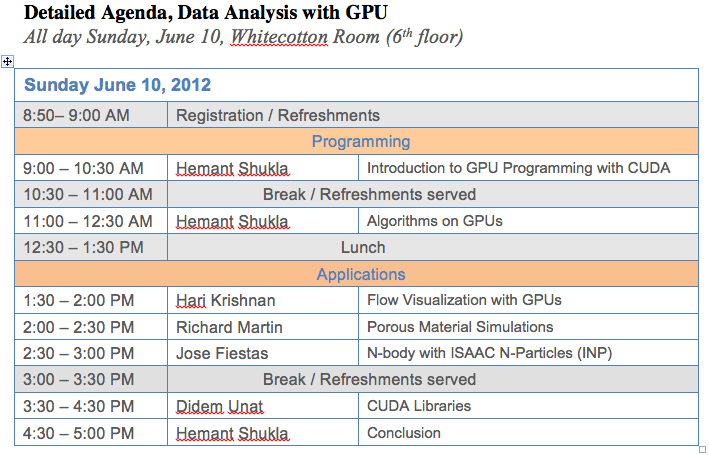Pre-Conference Tutorials and Workshops
RT2012 will offer in-depth tutorials and workshops the weekend before the conference. These sessions are offered at an additional fee, as shown on the Registration page. Choose from among them when you register for RT2012.ATCA and μTCA for Physics Experiments
Organizer: Ray Larsen, SLAC (xTCA Workshop Chair), along with Zheqiao Geng, SLAC (xTCA Program Chair) and Sergio Zimmermann, LBNL (RT2012 General Chair)This is a two day tutorial and workshop, all day Saturday, June 9 and Sunday, June 10.
We are pleased to invite you to the 6th ATCA /MicroTCA for Physics Workshop on Saturday and Sunday, June 9-10. The Workshop is organized under the auspices of IEEE and the Laboratory Members of the PICMG xTCA for Physics open standards consortium.
Its purpose is to bring together experts from labs and industry who are developing new systems based on the emerging standards, as well as introducing new engineers and physicists to the power of xTCA for physics. The ongoing roadmaps of standards committees will also be described in order to draw out comments and suggestions for important new hardware, firmware and software tools for physics. The key motivation of PICMG is that with lab-industry collaboration, both the development costs and the "time to market" for new applications can be significantly reduced to the benefit of all participants.
Click here for a detailed program for the ATCA and μTCA for Physics Experiments Workshop, including speakers and their topics and time slots. Revised June 5.
All slides and related materials from the talks will be made available for downloading from the RT2012 website at the conclusion of the conference.
Registration for the xTCA Workshop is $200 in addition to the RT2012 registration fee.
Data Acquisition Systems
Organizer: Mariano Ruiz, Technical University of Madrid This is a half-day tutorial on the afternoon of Saturday, June 9.This tutorial will review implementations of data acquisition systems and review different solutions based on the following standards: PCI, PCIe, USB, and PXI/PXIe. It will provide examples of implementation and discuss synchronization of DAQ devices; data acquisition and time-stamping using the IEEE 1588-2008 standard; implementation using intelligent data acquisition cards based on FPGA; and operating system constraints/alternatives: Windows vs. LINUX.
The topics covered in the tutorial will be:
- Basic DAQ Hardware Architectures
- Analog inputs: Multiplexed DAQ devices
- Analog Inputs: Simultaneous DAQ devices
- Analog outputs.
- Digital Input/Output.
- Timing.
- Standards used for DAQ applications.
- DAQ devices using PCI and PCIe.
- DAQ devices implementation with PXI/PXIe mechanical format.
- DAQ devices using USB.
- Software for DAQ applications.
- Using Windows vs. Linux OS. Advantages/Drawbacks.
- Advanced data acquisition systems
- Synchronization of multiple DAQ devices in the same computer and chassis.
- Synchronization in the distributed data acquisition system using IEEE 1588-2008.
- Implementation of advanced data acquisition applications using FPGA based DAQ devices.
Data Analysis with GPU
Organizer: Hemant Shukla, Lawrence Berkeley National LaboratoryThis is an all-day tutorial on Sunday, June 10.
An exciting development in the computing industry has been the emergence of graphics processing units (the GPU) as a fast general purpose co-processor. Initially designed for gaming applications, todays GPUs demonstrate impressive computing power and high levels of parallelism and are now being used for a variety of applications far removed from traditional graphics rendering settings.
Perhaps the most powerful use of the GPU has been in visualization, which couples the raw computing power of the GPU with its extensive capabilities for rendering scenes. The GPU provides the required computing power and real-time interactive rendering capabilities and there are now GPU-assisted algorithms for many fundamental problems in data visualization and analysis, including such basic primitives as matrix operations, FFTs, wavelet transforms, clustering and mining data streams. This is an exciting and fast developing area, and the tools and technique are now mature enough that researchers with no experience in using the GPU can use it to develop new data mining tools.
The purpose of this tutorial is to introduce to the audience the GPU technique and the programming model it represents, describe the ways in which one can program the GPU. The tutorial covers the main obstacles to performance such as conflicts in critical resources leading to serialization, load imbalance and memory bandwidth bottlenecks where some fundamental algorithms strategies enable to overcome these limitations. The tutorial also includes parallelism paradigms where counterintuitive approach may be more efficient. Finally, "register/memory tiling", "layout transformation" and "thread coarsening" will be presented as possible solutions to the problem of resources oversubscription such as memory access in GPU algorithms.
 |
 |
Hosted by Lawrence Berkeley National Laboratory, a U.S. Department of Energy national laboratory operated by the University of California |  |
